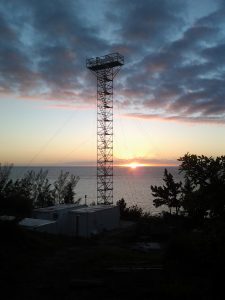 The lower level of the atmosphere, also called the troposphere, over the oceans plays important roles in the global distribution of organic compounds, nutrients, microbes, and pollutants. However, at the present time, many aspects of atmospheric composition, atmospheric transport, and land-atmosphere-ocean exchange remain poorly understood, which limited our ability to predict and mitigate the effects of anticipated future environmental change. This provides a strong motivation for current and emerging international research initiatives–such as SOLAS, IGAC, and GEOTRACES–that include research activities concerning the physics and chemistry of the marine troposphere, air-sea exchange processes, and long-range atmospheric transport. Central to such activities is the ability to observe and sample the marine boundary layer (MBL), in which oceanic island observatories have played a crucial role.
The lower level of the atmosphere, also called the troposphere, over the oceans plays important roles in the global distribution of organic compounds, nutrients, microbes, and pollutants. However, at the present time, many aspects of atmospheric composition, atmospheric transport, and land-atmosphere-ocean exchange remain poorly understood, which limited our ability to predict and mitigate the effects of anticipated future environmental change. This provides a strong motivation for current and emerging international research initiatives–such as SOLAS, IGAC, and GEOTRACES–that include research activities concerning the physics and chemistry of the marine troposphere, air-sea exchange processes, and long-range atmospheric transport. Central to such activities is the ability to observe and sample the marine boundary layer (MBL), in which oceanic island observatories have played a crucial role.
With regard to research focusing on the marine troposphere, the North Atlantic is one of the best studied, yet most challenging oceanic regions, since it is impacted by multiple sources of anthropogenic and natural aerosols and gases, thus contributing to a complex biogeochemical system. The oceanic island of Bermuda, located in the western North Atlantic subtropical gyre, receives emissions from all of these sources, depending on daily- to seasonal-scale changes in atmospheric circulation. As a result, Bermuda has played an important role in numerous field studies concerning long-range atmospheric transport and ocean-atmosphere exchange processes, including several major field research programs.
The island is well-equipped for such research, with the 23-meter high atmospheric sampling tower and site laboratories at Tudor Hill. Routine facility operations include the collection of continuous meteorological data and weekly bulk aerosol and rainwater samples, which are archived at the Bermuda Institute of Ocean Sciences (BIOS) and made freely available to the scientific community.
The facility is a regional station within the WMO’s Global Atmosphere Watch (GAW) Programme, and since 1989 the facility has served as a Global Greenhouse Gas Reference Network site, enabling the sampling of air for NOAA’s Earth System Research Laboratory. Since 2007 the Tudor Hill Marine Atmospheric Observatory has been part of the NASA AERONET program’s network of ground-based aerosol remote sensing sites, which provides globally distributed observations of spectral aerosol optical depth, inversion products, and precipitable water using photometers, such as those installed on the Tudor Hill tower.
Other long-term activities at the facility include instrument operation and maintenance for NOAA’s Tropospheric Ozone Monitoring Network (Earth System Research Laboratory, Global Monitoring Division) since 1988; and, since 2004, sampling for the Global Atmospheric Passive Sampling (GAPS) Network, a research program of Environment and Climate Change Canada providing comparable global-scale data for the distribution of persistent organic pollutants in the atmosphere.
Contact Information
Dr Andrew Peters
Director of University Programs & Associate Scientist
andrew.peters@bios.edu
Tel: 441-297-1880 x 240

